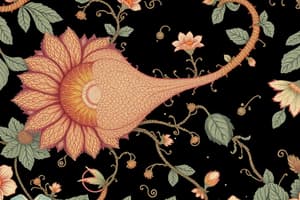Podcast
Questions and Answers
What is the main difference between asexual and sexual reproduction?
What is the main difference between asexual and sexual reproduction?
Asexual reproduction produces genetically identical offspring, while sexual reproduction produces genetically diverse offspring.
What is the purpose of meiosis in sexual reproduction?
What is the purpose of meiosis in sexual reproduction?
To produce gametes (sex cells) through two successive cell divisions.
What are the two main methods of fertilization?
What are the two main methods of fertilization?
External fertilization (outside the body) and internal fertilization (inside the body).
What is the result of the fusion of two gametes during fertilization?
What is the result of the fusion of two gametes during fertilization?
What is the term for the exchange of genetic material between homologous chromosomes during meiosis?
What is the term for the exchange of genetic material between homologous chromosomes during meiosis?
What is the process called when a parent organism breaks into fragments, each of which grows into a new individual?
What is the process called when a parent organism breaks into fragments, each of which grows into a new individual?
Flashcards are hidden until you start studying
Study Notes
Types of Reproduction
Asexual Reproduction
- Occurs in single-celled organisms, such as bacteria and protists
- Involves the production of genetically identical offspring from a single parent cell
- Methods include:
- Binary fission: cell divides into two identical daughter cells
- Budding: new individual grows from a bud on the parent organism
- Fragmentation: parent organism breaks into fragments, each of which grows into a new individual
Sexual Reproduction
- Involves the fusion of gametes (sex cells) from two parents to form a zygote
- Produces genetically diverse offspring due to crossing over and independent assortment of chromosomes
- Occurs in most multicellular organisms, including animals, plants, and fungi
- Methods include:
- External fertilization: gametes combine outside the body (e.g., in water)
- Internal fertilization: gametes combine inside the body (e.g., in animals)
Stages of Sexual Reproduction
Meiosis
- Process by which gametes are produced
- Involves two successive cell divisions, resulting in four haploid gametes
- Key events include:
- Crossing over: exchange of genetic material between homologous chromosomes
- Independent assortment: random alignment of chromosomes during cell division
Fertilization
- Fusion of two gametes to form a diploid zygote
- Can occur internally (in animals) or externally (in plants and some animals)
Embryogenesis
- Development of the zygote into a multicellular organism
- Involves multiple cell divisions, growth, and differentiation of tissues and organs
Reproduction
Asexual Reproduction
- Occurs in single-celled organisms like bacteria and protists
- Produces genetically identical offspring from a single parent cell
- Methods:
- Binary fission: one cell divides into two identical daughter cells
- Budding: new individual grows from a bud on the parent organism
- Fragmentation: parent breaks into fragments, each growing into a new individual
Sexual Reproduction
- Involves fusion of gametes from two parents to form a zygote
- Produces genetically diverse offspring due to crossing over and independent assortment of chromosomes
- Occurs in most multicellular organisms, including animals, plants, and fungi
- Methods:
- External fertilization: gametes combine outside the body (e.g., in water)
- Internal fertilization: gametes combine inside the body (e.g., in animals)
Meiosis
- Process by which gametes are produced
- Involves two successive cell divisions, resulting in four haploid gametes
- Key events:
- Crossing over: exchange of genetic material between homologous chromosomes
- Independent assortment: random alignment of chromosomes during cell division
Fertilization
- Fusion of two gametes to form a diploid zygote
- Can occur internally (in animals) or externally (in plants and some animals)
Embryogenesis
- Development of the zygote into a multicellular organism
- Involves multiple cell divisions, growth, and differentiation of tissues and organs
Studying That Suits You
Use AI to generate personalized quizzes and flashcards to suit your learning preferences.



